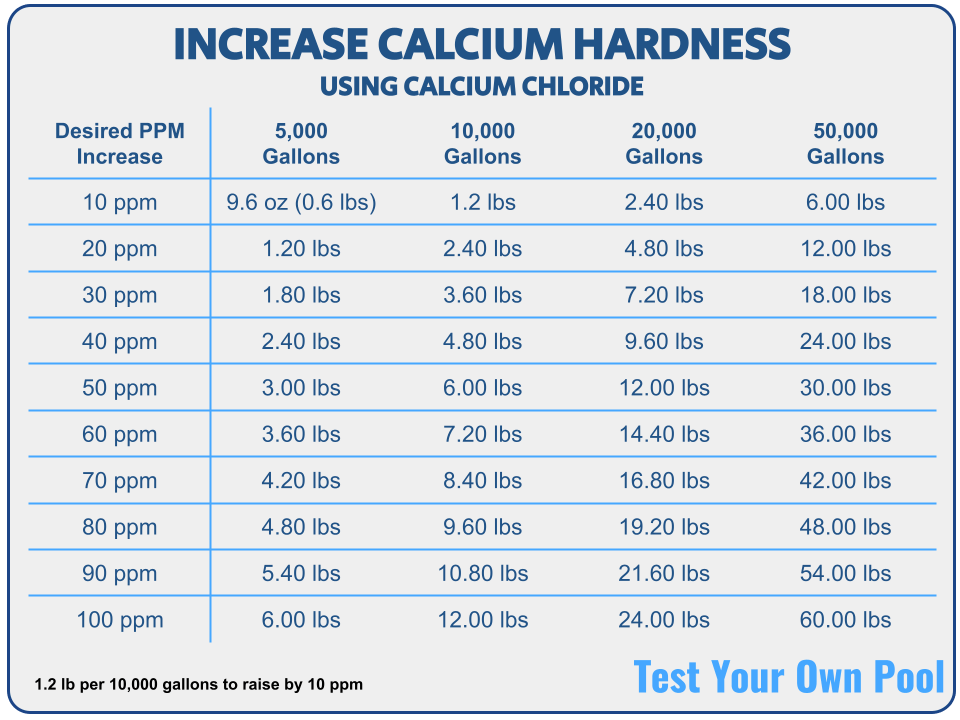Calcium hardness (CH) determines how hard or soft the water is in your pool.
If left unchecked and untested, it can cause serious damage to the pool equipment, surface, and water chemistry.
Keeping calcium levels balanced isn’t difficult, but it is necessary for a pool’s overall health.
Understanding Calcium’s Effect on Pool Water
The pool’s water is either hard or soft.
Hard water has excess minerals, including calcium. Particularly in homes, it can damage pipes, cause staining and scaling, harm your hair, and dry out your skin.
Most homes with hard water problems solve this by getting a water softener system, which, you guessed it, makes water “softer”.
Soft water has minimum calcium and other minerals. It’s generally less harsh and is a better swimming, and showering, experience.
What Does Calcium Hardness Measure?
As the name mentions, calcium hardness (CH) measures the number of dissolved minerals (calcium primarily, but also magnesium, lime, etc.) in water.
Essentially, the hardness or softness of pool water.
What happens if Calcium Hardness is not Balanced?
One important point to understand is that water will normally find its balance, meaning if water is too hard or too soft, it will try to find equilibrium on its own at the expense of your surface and equipment. This issue is primarily targeted toward concrete and plaster pool owners.
Pools that have too much calcium (hard) will start to scale. This can plug filters and pipes, reducing circulation and forming crusty white deposits on a pool’s surface.
Pools with too little calcium (soft) will aggressively draw calcium from whatever source they can find. This etches plaster, pits concrete, and pool decks, and can dissolve the grout from tile lines.
| Low Calcium Hardness (Corrosion) | High Calcium Hardness (Scaling) |
|---|---|
| Etches plaster | White deposits on surface |
| Pits concrete | Plugs filters |
| Pits pool decks | Water cloudiness |
| Dissolves grout | Heater efficiency issues |
| Tiles pop off easier | Circulation reduction |
The best way to combat this aggression is to always ensure it is in balance. And the only way to find that out is by testing your calcium hardness levels.
Testing for Calcium Hardness in a Pool
Most testing kits are fully equipped to find test calcium hardness levels.
Test strips only measure total hardness, which includes calcium and magnesium. There is no true reading of CH levels with strips.
It is highly recommended that a proper testing kit be used to ensure an accurate reading of CH levels in the pool.
What Should My Calcium Hardness Level Be?
For concrete or plaster pools, calcium hardness should be between 250 to 550 ppm.
With Vinyl and fiberglass pools, calcium hardness should be between 100 to 300 ppm.
There is a wide variety of recommendations for vinyl pools, in particular. Some smart folks think calcium isn’t necessary and shouldn’t even be considered in vinyl pools
While it isn’t as important as a concrete pool, it is smart to at least have some in there.
Some equipment manufacturers may even require a minimum ppm of calcium to maintain their warranty. Just don’t overshoot it!
Also, depending on how it was manufactured, some fiberglass could contain calcium. If unsure, follow the concrete pool guidelines to be safe. It can’t hurt!
How To Lower Calcium Hardness in Pool
In certain areas of the country with hard water, high calcium levels are pretty common. While it is possible to maintain a higher-than-recommended calcium level, it will require meticulous control of the overall water balance and, more importantly, ensuring pH and total alkalinity (TA) levels compensate for that higher calcium.
There really is only one true way to lower calcium levels, and that is to drain and refill some of the pool water.
Before refilling, test the tap water or wherever the water is coming from for calcium. If it is just as high or above the recommended level, try running it through a water softener if available (assess the risks of overuse) or buy a filter for the hose.
How to Raise Calcium Hardness in Pool
Calcium hardness can be increased by calcium chloride, most commonly found in deicers and ice melts if you live in a colder climate.
It is typically the most cost-effective buying as an ice melt in 30-50 pound bags or buckets. Ideally, that will last a season or two, depending on the need.
Most pool stores will also sell both calcium chloride and calcium chloride dihydrate under names like Calcium Hardness Increaser and Hardness Plus. These are typically at much lower quantities and a higher price point.
Calcium hardness can be increased by adding 1.2 lbs of calcium chloride for every 10,000 gallons. This will raise CH by 10 ppm.
Use our calcium hardness calculator or refer to the graph below for proper dosage.

To add calcium chloride to the pool:
- Broadcast the recommended calcium chloride in the deep end.
- Brush the walls and floor so the calcium chloride dissolves quicker. For plaster pools, this is important so calcium doesn’t stick to the walls
If you decide to mix the calcium chloride in a bucket of water before pouring, take precautions as calcium chloride will get extremely hot in the bucket. Use proper PPE — gloves and goggles — when handling it in a bucket.
Keeping It All Balanced
One common theme around testing is balance and harmony. Each part plays a pivotal roles in keeping your water clear and healthy.
No level is more important than the other; it only takes one to knock everything off balance. Calcium is no exception. While corrosion doesn’t happen overnight, longer periods of inaction can lead to serious consequences. By testing weekly, there shouldn’t be any surprises or shocking results on your levels.
After all, it’s about swimming in the water, not worrying!


